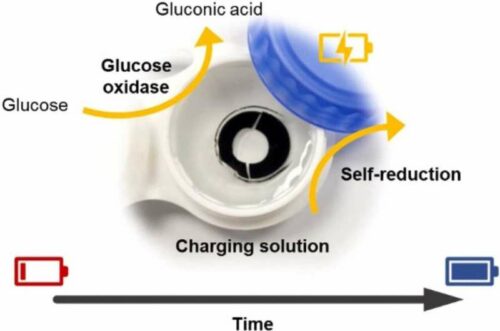- Marrying healthcare and cutting-edge tech, smart contact lenses stand as a testament to the future of vision care.
- Dive into the innovation of a flexible, cornea-thin battery designed to power these lenses, all while being biocompatible and safe for the eye.

Smart contact lenses represent the fusion of advanced technology with healthcare. These are not average contact lenses; they’re embedded with micro-technologies that can project visual data directly onto our corneas, functioning as miniaturised computer screens for our eyes. This innovation opens the door to augmented reality (AR), overlaying digital information in the real world.
Scientists from Nanyang Technological University (NTU) Singapore have developed a flexible battery as thin as a human cornea, which stores electricity when immersed in saline solution. They could one-day power smart contact lenses. Associate Professor Lee Seok Woon led the battery’s development at NTU’s School of Electrical and Electronic Engineering (EEE).
Smart Lenses: Vision Correction Meets Health Tech & AR
These lenses were designed to address basic eye conditions, offering a modern solution to correcting vision. Beyond just vision correction, these smart lenses are now integrated with sensors and data transmission mechanisms that can continuously monitor the health metrics of the wearer. For people living with chronic health issues like diabetes, these lenses can be life-changing. They can detect glucose levels in tears, offering a non-invasive method to track blood sugar levels. For glaucoma patients, the lenses can monitor intraocular pressure, giving real-time data that can be crucial for managing the condition. They can alert wearers to potential health issues, offer reminders for medication, or even provide augmented overlays to assist in daily activities. The merger of health monitoring and augmented reality in such an unobtrusive form factor makes smart contact lenses revolutionary in tech and healthcare domains.
Saline-Powered, Wire-free Safe Battery
The NTU-developed battery is made of biocompatible materials and does not contain wires or toxic heavy metals, such as those in lithium-ion batteries or wireless charging systems. It has a glucose-based coating that reacts with the sodium and chloride ions in the saline solution surrounding it. At the same time, the water the battery contains serves as the “wire” or “circuitry” for generating electricity. Existing rechargeable batteries rely on wires or induction coils that contain metal and are unsuitable for use in the human eye, as they are uncomfortable and present risks to the user.
In the future, smart contact lenses could be developed to record and transmit everything a wearer sees and hears to cloud-based data storage. To reach this future potential, a safe and suitable battery needs to be developed to power them. Human tears could also power the battery as they contain sodium and potassium ions at a lower concentration. Testing the current battery with a simulated tear solution, the researchers showed that the battery’s life would be extended an additional hour for every twelve-hour wearing cycle. The battery can also be charged conventionally by an external power supply.






